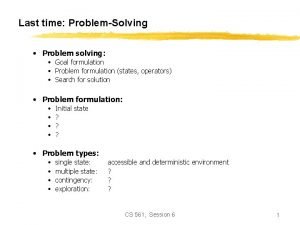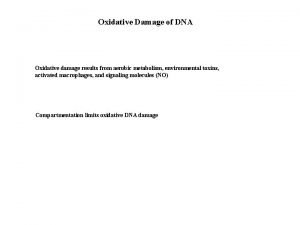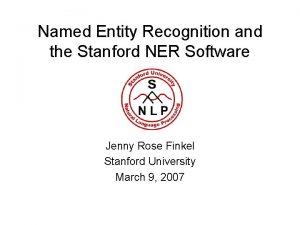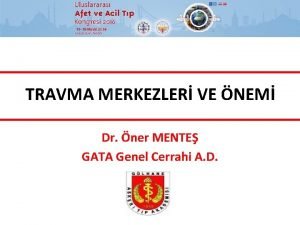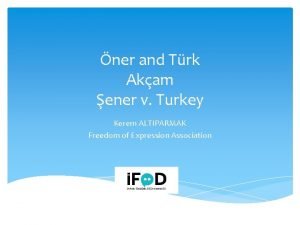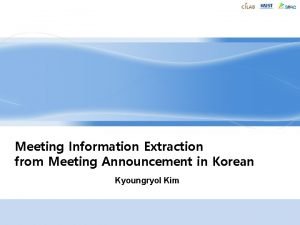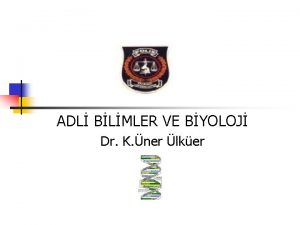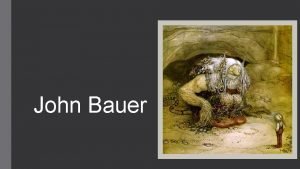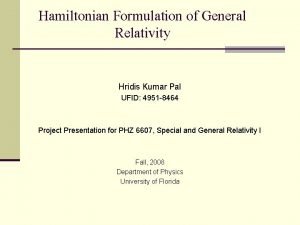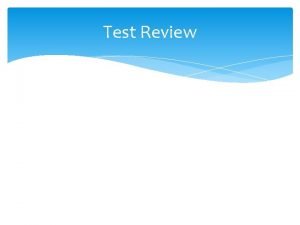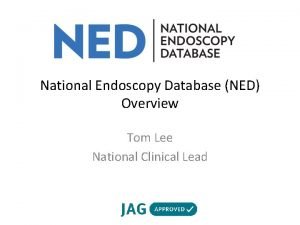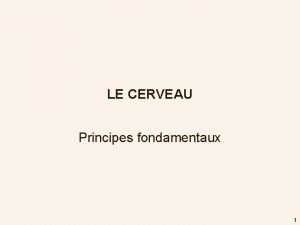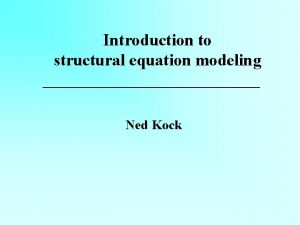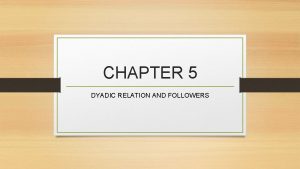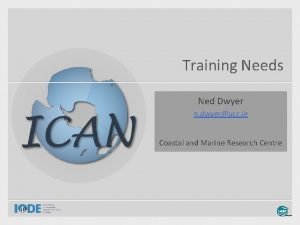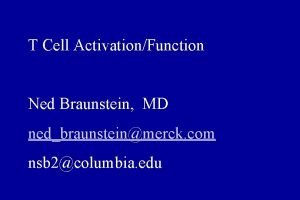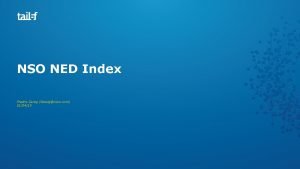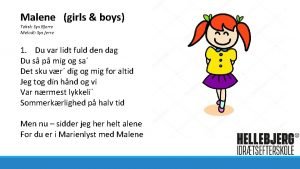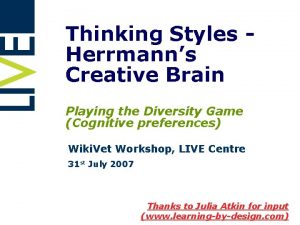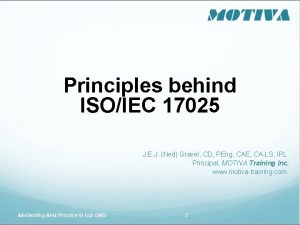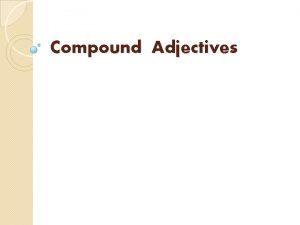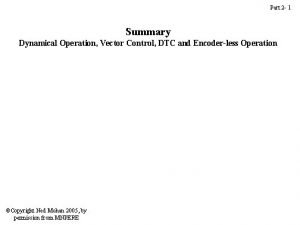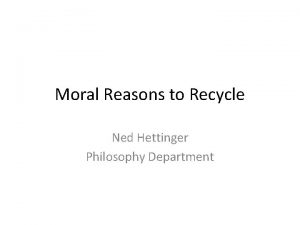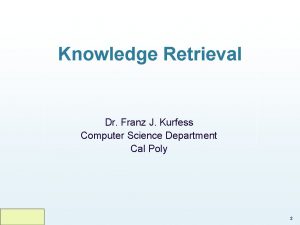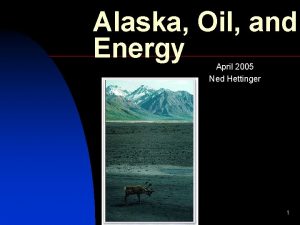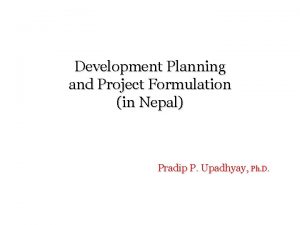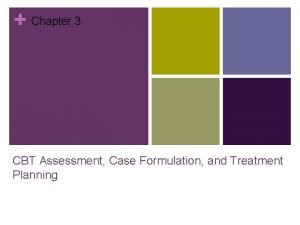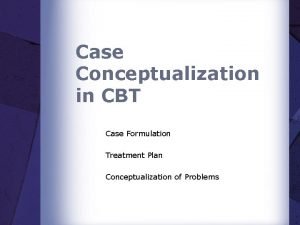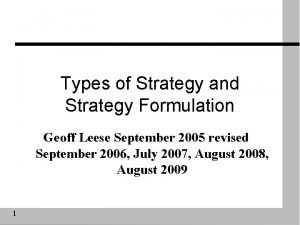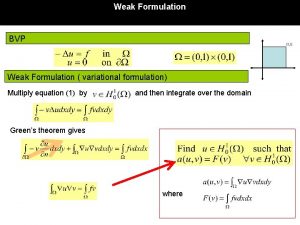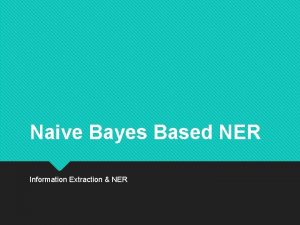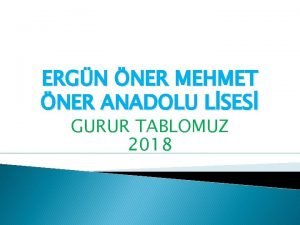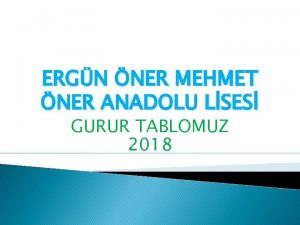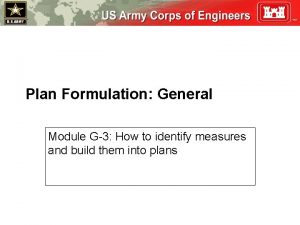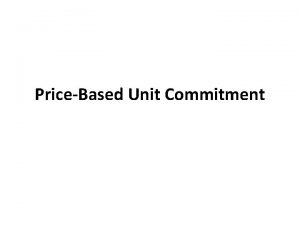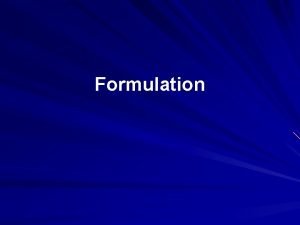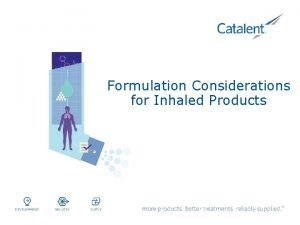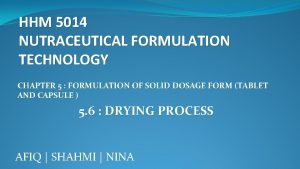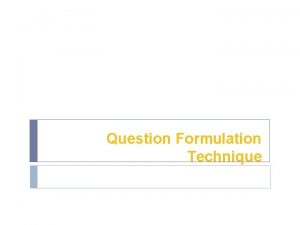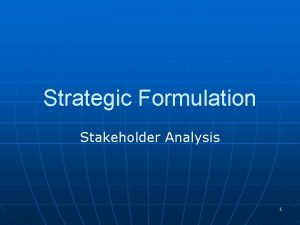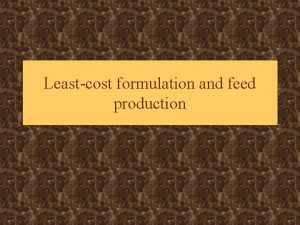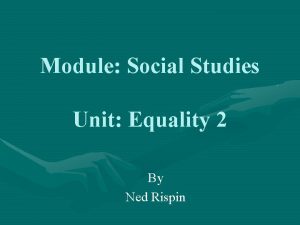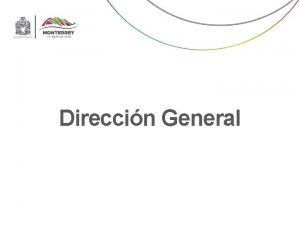Plan Formulation General Module G4 NED Plan NER















































- Slides: 47

Plan Formulation: General Module G-4: NED Plan, NER Plan, Combined Plan, Other Plans

Student Learning Objectives Student will be able to: § Define NED and NER Principles § Plan with Environmental Operating Principles § Recognize the linkage between single purpose and multi-purpose strategies G 2 - 2 BU ILDING STRONGSM

Evaluation Concepts NED NER Methods of Comparison Annual Benefits and Costs Optimization/Incremental Analysis G 2 - 3 BU ILDING STRONGSM

NED and NER NED – National Economic Development – Increases in the net value of the national output of goods and services expressed in monetary units. NER – National Ecosystem Restoration – Increases in the net quantity and/or quality of desired ecosystem resources. G 2 - 4 BU ILDING STRONGSM

Methods of Comparison § Before and After § With and Without § Gap Analysis G 2 - 5 BU ILDING STRONGSM

20 - 10 - 0 NOW TIME +20 YEARS

20 - 10 - Existing 0 NOW TIME +20 YEARS

Target 20 - 10 - Existing 0 NOW TIME +20 YEARS

Target 20 - 10 - Futu re W ithou t Existing 0 NOW TIME +20 YEARS

Target 20 - 10 - Future with Plan A Futur e Wit hout Existing 0 NOW TIME +20 YEARS

Target 20 - 10 - Future with Plan A Futur e Wit hout Existing 0 NOW TIME +20 YEARS

Target 20 - 10 - Future with Plan A Futur B&A e Wit hout Existing 0 NOW TIME +20 YEARS

Target 20 - 10 - Future with Plan A B&A W & WO Futur e Wit hout Existing 0 NOW TIME +20 YEARS

Target 20 Gap 10 - Future with Plan A B&A Futur W & WO e Wit hout Existing 0 NOW TIME +20 YEARS

Target 20 Gap 10 - Future with Plan A B&A Futur W & WO e Wit hout Existing 0 NOW TIME +20 YEARS

NED Analysis § Definitions § What’s in and What’s Out § Maximization of Net Benefits G 2 - 16 BU ILDING STRONGSM

Average Annual Benefits and Costs § All measurable NED benefits and costs must be included in the average annual benefits and costs of a project. § Average annual benefits and costs are the present worth (in project year one, the base year) of the dollar streams, amortized over the period of economic evaluation. § More important for this course, than the techniques and formulas for annualizing benefits and costs is: what benefits and costs are included and excluded.

What’s In § All opportunity costs (not just out of pocket costs) e. g. , interest during construction § Future costs (and benefits), including any projected increase in OM&R § All the resource costs needed to make the project complete § Mitigation costs are included and allocated to the appropriate purpose. What’s Out § Benefits which are regional in nature (taken from another part of the country) § Transfers from one group to another (income redistribution) § Dollar costs which are not opportunity costs: recoverable business losses § Costs associated with indirect project effects.

Maximization of Net Benefits: An Example

Net Benefits: A Concept G 2 - 20 BU ILDING STRONGSM

Net Benefits: A Concept Combination with the greatest net benefit = 53 G 2 - 21 BU ILDING STRONGSM

Net Benefits: For Different Scales of Measure B (prior slide) G 2 - 22 Scale Net Benefits Size 1 40 Size 2 50 Size 3 35 BU ILDING STRONGSM

Net Benefits: Changing Scale Can Change Incremental Analysis G 2 - 23 BU ILDING STRONGSM

Maximization of Net Benefits $ Total Benefits Maximum Benefits Total Cost Maximum Cost Output* Maximum of net benefits achieved at Output* Output

NER Analysis § Traditional B/C Analysis not possible with nonmonetary benefits § Cost-Effectiveness/Incremental Cost Analysis (CE/ICA) § offers “next-best’ approach § bridges the decision-making gap § “getting the most for our money” G 2 - 25 BU ILDING STRONGSM

Cost-Effectiveness/Incremental Cost Analysis Definitions § Cost-Effectiveness § Conducted to ensure that the least cost alternative is identified for each possible level of output § Incremental Cost Analysis § Reveals changes in costs as output levels increase, § Allows an assessment of whether the increase in output is worth the additional cost G 2 - 26 BU ILDING STRONGSM

Cost Effectiveness Incremental Cost Analysis § Comparison of costs/outputs across differing units of measurement § Does not identify unique optimal solution § Can identify the least-cost alternative for producing every attainable level of output G 2 - 27 BU ILDING STRONGSM

Solutions, Costs and Outputs COST EFFECTIVENESS ANALYSIS INCREMENTAL COST ANALYSIS CEA/ICA … Bringing it all together G 2 - 28 BU ILDING STRONGSM

NER Plan – Selection Considerations § Planning Objectives and constraints § Significance of output § Reasonably maximizes environmental benefits § Pass tests of CE/ICA § Four formulation criteria G 2 - 29 BU ILDING STRONGSM

EC 1105 -2 -404 PLANNING CIVIL WORKS PROJECTS UNDER THE ENVIRONMENTAL OPERATING PRINCIPLES G 2 - 30 BU ILDING STRONGSM

EC 1105 -2 -409 Planning in a Collaborative Environment (24 June 2005) G 2 - 31 BU ILDING STRONGSM

Planning in a Collaborative Environment EC 1105 -2 -409 Purpose § Provide revised procedures for the conduct of Corps water resources planning and the preparation of feasibility (decision) reports § Moves Corps towards developing more comprehensive solutions to water resources problems while maintaining existing, effective processes – becoming more relevant to today’s National needs and priorities G 2 - 32 BU ILDING STRONGSM

OVERVIEW § Strive to achieve environmental sustainability § “Seek balance and synergy among human development activities and natural systems by designing economic and environmental solutions that support and reinforce one another. ”, Environmental Operating Principles, March 2002 § Contribute to environmental sustainability as defined in EOP’s by formulating Combined NED/NER plans § Combined NED/NER Plan = Combined Plan G 2 - 33 BU ILDING STRONGSM

Basic Principles § § § Operationalize EOP’s Comply with P&G principles and requirements Incorporate existing procedures and tools § § § G 2 - 34 Benefit/Cost analysis Cost effectiveness/Incremental cost analyses (IWR -PLAN) Optimization procedures BU ILDING STRONGSM

Environmental Sustainability § Results when economic and environmental considerations are effectively balanced through the life cycle of project planning, design, construction, operations and maintenance to improve the quality of the natural and human environment for present and future generations. § The Corps will achieve a better balance between economic and environmental benefits through the formulation of alternative plans that integrate both National Economic Development (NED) outputs and National Environmental Restoration (NER) outputs in accordance with existing planning regulations. G 2 - 35 BU ILDING STRONGSM

STEPS 1 AND 2 : DEFINE PROBLEMS AND OPPORTUNITIES; INVENTORY AND FORECAST § Include both economic development and ecosystem restoration problems and opportunities. § Define planning objectives and constraints. § Output: Clear definition of future without project condition. G 2 - 36 BU ILDING STRONGSM

STEP 3: FORMULATE PLANS § Consider all reasonable measures and plans. § § Structural Non-structural Dependent or not dependent on other measures All practicable measures to avoid or minimize adverse environmental impacts. Look for synergies! G 2 - 37 BU ILDING STRONGSM

STEP 3: FORMULATE PLANS § As one strategy, start with a primary purpose: NED or NER § § Formulate plans to address primary purpose Identify NED or NER Plan Required for comparison/cost allocation purposes Develop additional strategies: § § G 2 - 38 To formulate combined plans to take advantage of synergies created by NED or NER Plan To formulate other combined plans to address multiple purposes BU ILDING STRONGSM

STEP 4: EVALUATION § Assess benefits across purposes. § Conduct trade-off analysis: § Identify cost effective plans using both NED and NER outputs § Identify decision criteria: § National economic development benefits § National ecosystem restoration outputs § Total project cost § Determine if plans are justified G 2 - 39 BU ILDING STRONGSM

STEPS 5 AND 6 : COMPARISON AND SELECTION § Comparison § Rank Plans § Compare highest ranked plan to NED or NER Plan. Consider benefits foregone, benefits gained, differences in cost and other decision criteria. § Document rationale for selecting Combined Plan over NED or NER Plan. However, other considerations may also apply G 2 - 40 BU ILDING STRONGSM

SUMMARY POINTS § Intended to encourage broader plan formulation consistent with EOP’s § Allows consideration of all criteria in the evaluation process regardless of the unit of measurement § Justified Combined Plan must be identified § Must document trade-offs between NED or NER Plan and Combined Plan and the rationale for plan selection G 2 - 41 BU ILDING STRONGSM

Comparison/Selection Concepts § NED Plan § NER Plan § Combined Plan § Locally Preferred Plans § Other named plans G 2 - 42 BU ILDING STRONGSM

Sometimes, It Helps to Know Where You Are Going, Before You Decide How to Get There So Let’s Look Way Ahead: § At the 6 th step of the § The NED Plan reasonably maximizes net planning process, you will benefits be asked to identify: § The NER Plan reasonably maximizes § An NED plan environmental net benefits (not in dollars, § An NER plan of course) § A Combined plan § The Combined Plan is one which § A LPP plan provides the optimal mix of monetary and non-monetary benefits § Other plans § The LPP is the locally preferred plan, which may be smaller, larger or otherwise different than the Federal plan G 2 - 43 BU ILDING STRONGSM

Plan Designations § NED Plan (National Economic Development Plan) (P&G) § LEDPA: Least Environmentally Damaging Practicable Alternative (CWA) § Nonstructural Plan (WRDA 86) § NER Plan (National Ecosystem Restoration Plan) § Reasonable & Prudent Alternative (ESA) § Combined Plan § No Action Plan (NEPA) § LPP (Locally Preferred Plan) § Environmentally Preferred Plan (NEPA)

Plan Selection - EC 1105 -2 -409 § All planning studies will evaluate, display and compare the full range of alternative plans’ effects across all four Principles and Guidelines’ accounts. § NED, RED, EQ, and Social Effects § A plan may be a candidate for selection if it has, on balance, net beneficial effects. § May select and recommend any one of the candidate plans – (ASA(CW) exception needed if not NED or NER plan) § The basis for selection will consider the beneficial and adverse effects in all four accounts § Must identify an NED plan (for comparison) and establishing Corps financial participation in the recommended plan. G 2 - 45 BU ILDING STRONGSM

Take Away Points § Often we don’t get the fundamentals right -- According to Washington level reviewers, the three most common formulation errors are without project conditions, and without project conditions. § There is a lot of terminology to keep straight § The default choice for plan selection is the no action § While the normal choice for plan selection is the NED, NER, or Combined Plan, a LPP is an option G 2 - 46 BU ILDING STRONGSM

Where are we going next? § Question: What are some recent projects you have worked on that included both NED and NER outputs? How were these projects formulated? G 2 - 47 BU ILDING STRONGSM
 Ned ner
Ned ner Why problem formulation follow goal formulation
Why problem formulation follow goal formulation Gross enrollment ratio formula
Gross enrollment ratio formula Ner
Ner Stanford ner
Stanford ner Dr ner
Dr ner Turk ner
Turk ner Ner relation extraction
Ner relation extraction Adli bilimler nedir
Adli bilimler nedir John bauer
John bauer Hamiltonian formulation of general relativity
Hamiltonian formulation of general relativity C device module module 1
C device module module 1 Bart simpson personality traits
Bart simpson personality traits Ned is a typewriter repairman
Ned is a typewriter repairman Ned language
Ned language National endoscopy database
National endoscopy database Ned herrmann
Ned herrmann Ned kock
Ned kock Flaggtider nord norge
Flaggtider nord norge Ned herman
Ned herman The potter and rosenbach followership model
The potter and rosenbach followership model Cisco nso ned
Cisco nso ned Ned hettinger
Ned hettinger Ned dwyer ucc
Ned dwyer ucc Ned braunstein
Ned braunstein Ned
Ned Nasa ned
Nasa ned Malene sang tekst
Malene sang tekst Ned herrmann
Ned herrmann Ned gravel
Ned gravel Pv ned
Pv ned Adjectives for dinner
Adjectives for dinner Ned mohan
Ned mohan Ned hettinger
Ned hettinger Ned kurfess
Ned kurfess Yale project management
Yale project management Nso ned
Nso ned Ned kock
Ned kock Ned hettinger
Ned hettinger Process of plan formulation in nepal
Process of plan formulation in nepal Case formulation cbt example
Case formulation cbt example Cbt case conceptualization example
Cbt case conceptualization example Diferencia entre gran plano general y plano general
Diferencia entre gran plano general y plano general Where did general lee surrender to general grant?
Where did general lee surrender to general grant? Role of hrm in strategy formulation
Role of hrm in strategy formulation Types of strategy formulation
Types of strategy formulation Spin finish oil formulation
Spin finish oil formulation Research design formulation
Research design formulation

